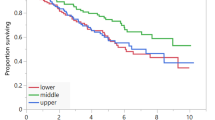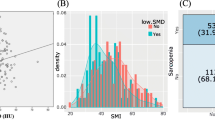Abstract
Sarcopenia is defined as a progressive and generalized muscle disorder associated with certain physiological and pathological conditions. We aimed to evaluate the prevalence of sarcopenia in patients with HL using 18-fluoro deoxyglucose (FDG) PET/CT, which would provide a data of muscle mass with the CT compartment and also data of muscle metabolism with the 18-FDG compartment of the imaging modality. Fifty-nine patients diagnosed with HL were included in the study. PET/CT images before and after treatment were evaluated with regard to lumbar muscle mass and metabolism. Mean lumbar muscle evaluation with CT before treatment was 92, 40 HU, and after treatment was 89, 41 HU. Mean metabolic tumor volume (MTV) evaluated with FDG PET before treatment was 4, 13 mm3 while after treatment was 4, 10 mm3. The lumbar muscle mass in terms of HU which was evaluated with CT was observed to be decreased after treatment. Likewise, the metabolic evaluation was observed to be also decreased after treatment. Despite the decline in muscle mass after treatment in the whole group, this decline was particularly observed in the better initial performance group. In patients with BMI > 32, there was a significant decline in muscle mass. Abdominal nodal involvement was related with poorer muscle mass and quality. In HL care, particular attention should be given to patients who are younger and with better physical condition in terms of preserving the muscle reserves and preventing sarcopenia.

Similar content being viewed by others
References
Cruz-Jentoft AJ, Bahat G, Bauer J, Boirie Y, Bruyère O, Cederholm T, Cooper C, Landi F, Rolland Y, Sayer AA, Schneider SM, Sieber CC, Topinkova E, Vandewoude M, Visser M, Zamboni M, Writing Group for the European Working Group on Sarcopenia in Older People 2 (EWGSOP2), and the Extended Group for EWGSOP2, Bautmans I, Baeyens JP, Cesari M, Cherubini A, Kanis J, Maggio M, Martin F, Michel JP, Pitkala K, Reginster JY, Rizzoli R, Sánchez-Rodríguez D, Schols J (2019) Sarcopenia: revised European consensus on definition and diagnosis. Age Aging 48:16–31
Schaap LA, van Schoor NM, Lips P, Visser M (2018) Associations of sarcopenia definitions and their components, with the incidence of recurrent falling and fractures: the longitudinal aging study Amsterdam. J Gerontol A Biol Sci Med Sci 73:1199–1204
McGregor RA, Cameron-Smith D, Poppitt SD (2014) It is not just muscle mass: a review of muscle quality, composition and metabolism during aging as determinants of muscle function and mobility in later life. Longev Healthspan 3(1):9. https://doi.org/10.1186/2046-2395-3-9
Schaap LA, Koster A, Visser M (2013) Adiposity, muscle mass, and muscle strength in relation to functional decline in older persons. Epidemiol Rev 35:51–65
Keng BMH, Gao F, Teo LLY et al (2019) Associations between skeletal muscle and Myokardium in aging: a syndrome of “cardio-sarcopenia”? J Am Geriatr Soc 67(12):2568–2573. https://doi.org/10.1111/jgs.16132
Yin J, Lu X, Qian Z, Xu W, Zhou X (2019) New insights into the pathogenesis and treatment of sarcopenia in chronic heart failure. Thernostics 9(14):4019–4029
Yang M, Shen Y, Tan L, Li W (2019) Prognostic value of sarcopenia in lung cancer: a systematic review and meta analysis. Chest 156(1):191–111
Gökyer A, Küçükarda A, Köstek O et al (2019) Relation between sarcopenia and dose-limiting toxicity in patients with metastatic colorectal cancer who received regorafenib. Clin Transl Oncol 21(11):1518–1523. https://doi.org/10.1007/s12094-019-02080-4
Hopancı Bıçaklı D, Çehreli R et al (2019) Evaluation of sarcopenia, sarcopenic obesity, and phase angle in geriatric gastrointestinal cancer patients: before and after chemotherapy. Turk J Med Sci 49(2):583–588
Go SII, Park MJ, Song HN (2016) Prognostic impact of sarcopenia in patients with diffuse large B cell lymphoma treated with rituximab plus cyclophosphamide, doxorubicin, vincristine and prednisolone. J Cachexia Sarcopenia Muscle 7:567–576
Chu MP, Lieffers J, Ghosh S (2017) Skeletal muscle density is an independent predictor of diffuse large B cell lymphoma outcomes treated with rituximab based chemoimmunotherapy. J Cachexia Sarcopenia Muscle 8:298–304
Lanic H, Kraut-Tauzia J, Modzelewski R (2014) Sarcopenia is an independent prognostic factor in elderly patients with diffuse large B cell lymphoma treated with immunochemotherapy. Leuk Lymphoma 55(4):817–823
Nakamura N, Hara T, Shibata Y (2015) Sarcopenia is an independent prognostic factor in male patients with diffuse large B cell lymphoma. Ann Hematol 94:20143–22053
Turkish Society of Hematology. Guidelines of the diagnosis and treatment of lymphomas (Version 2018) http://www.thd.org.tr/thdData/Books/83 Accessed September 2019
National Comprehensive Cancer Network. Hodgkin lymphoma (Version 2.2019) https://www.nccn.org/professionals/physician_gls/pdf/hodgkins.pdf Accessed September 2019
Küppers R, Schwering I, Bräuninger A et al (2002) Biology of Hodgkin's lymphoma. Ann Oncol 13(Suppl 1):11
Schmitz R, Stanelle J, Hansmann ML, Küppers R (2009) Pathogenesis of classical and lymphocyte-predominant Hodgkin lymphoma. Annu Rev Pathol 4:151–174
Liu WR, Shipp MA (2017) Signaling pathways and immune evasion mechanisms in classical Hodgkin lymphoma. Blood 130:2265–2270
Author information
Authors and Affiliations
Corresponding author
Ethics declarations
Conflict of interest
The authors declare that they have no conflict of interest.
Ethical approval
This study has been approved by the local ethical committee with the number 2019/322, compliant with 1964 Helsinki declaration.
Informed consent
Written informed consent has been obtained from all living patients.
Additional information
Publisher’s note
Springer Nature remains neutral with regard to jurisdictional claims in published maps and institutional affiliations.
Rights and permissions
About this article
Cite this article
Bas, V., Umit, E.G., Korkmaz, U. et al. Sarcopenia in Hodgkin’s lymphoma evaluated with 18-FDG PET/CT, focus on age, performance, and treatment. Support Care Cancer 29, 2475–2480 (2021). https://doi.org/10.1007/s00520-020-05772-8
Received:
Accepted:
Published:
Issue Date:
DOI: https://doi.org/10.1007/s00520-020-05772-8




